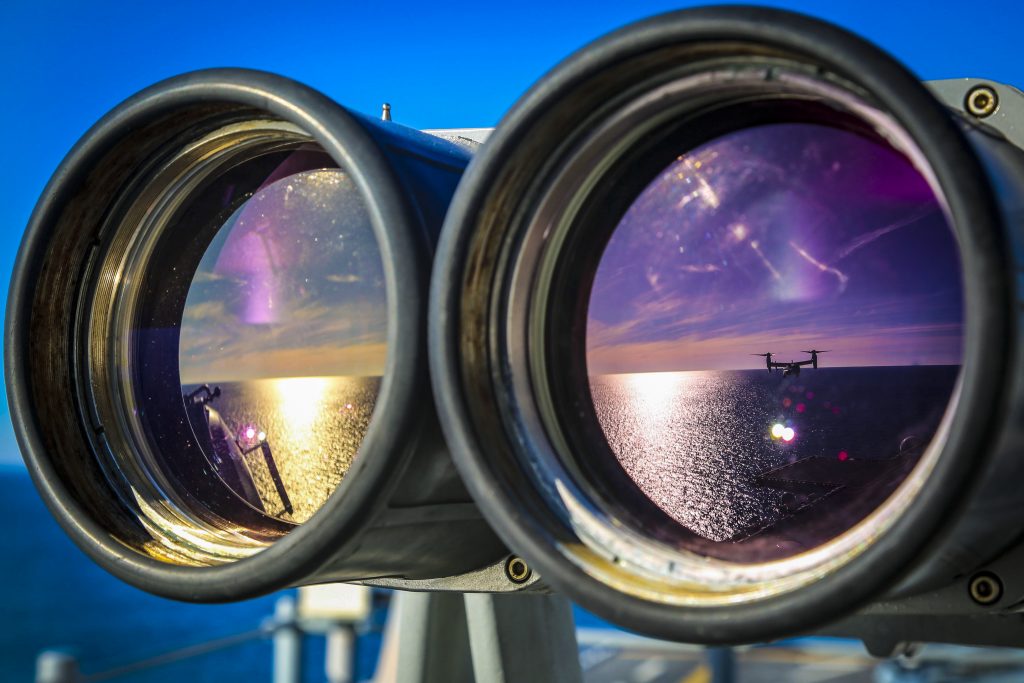There is virtually no part of a modern defense system that is not impacted in some way by optics and photonics, even when the system is not optically based. Modern defense systems are migrating toward optically based imaging, remote sensing, communications, and weapons. This trend makes maintaining leadership in optics and photonics vital to maintaining the U.S. position in defense applications.
Sophisticated platforms have reduced the need for a large set of traditional warfighters, but there is an increased need for a high-tech workforce to support those platforms. This workforce relies on advanced training in technical areas with a basis in science, technology, engineering, and mathematics (STEM), which are precisely the areas in which it is becoming more difficult to find continued optics and photonics education in the United States.

A strong national defense increasingly depends on many photonics technologies: precision laser machining, optical lithography for electronics, optical signal interconnects, solar power for remote energy needs, and generation of a stable timebase for the Global Positioning System (GPS). Even when the actual sensor is not optics-based, in many cases optics plays an important role, such as the migrating of radio frequency photonics into microwave radar systems.
Photo Courtesy U.S. Air Force
Advances in optics and material science are enabling new equipment for battlefield soldiers. Night vision contact lens comprised of graphene can be manufactured to overcome a major problem with larger, bulky night vision goggles: the need for additional cooling systems. These contact lenses may be used in the future by doctors who wish to monitor patient’s blood flow or historians who want to examine older layers of paint that are below the surface layer.


Sensor systems will be the next “battleground” for dominance in intelligence, surveillance, and reconnaissance, with optics based sensors representing a considerable fraction of these systems. Optical sensing technology provides the ability to communicate information at high bandwidths from mobile platforms and can also identify chemical, biological, and nuclear threats, an ability fundamental for homeland security.
Photo Courtesy U.S. Marines
Defense against missile attacks is a significant security need with laser weapons systems poised to cause a revolution in military affairs. Laser weapons can provide a substantial advantage for U.S. forces. There are also potential synergies from fully merging optical surveillance technology, laser weapons technology, and free-space laser technology.
Related Courses found in the B.S. in Photonic Science and Engineering Program at UCF:

The course covers three topics: 1) The optical fiber as a transmission channel. 2) Optoelectronic devices used in transmitters, receivers, and multiplexers. 3) Design of the overall communication system and assessment of its performance.

This course introduces the basic principles of two- and three-dimensional imaging systems. It includes the mathematics of image formation as a linear system and introduces point spread function, transfer function, resolution, and restoration. Objects such as microscopes, telescopes, and copiers operating in the gazing and scanning configurations are modeled and their resolution assessed. Interferometric imaging systems and their applications in metrology are described.

Laser Engineering and Lab
Includes the concept of a photon, processes of interaction of light with matter (and its application to detectors), the generation of light via spontaneous and stimulated emission, atomic transitions leading to fluorescence. Properties of lasers are introduced as the basis of optical amplifiers. Optical resonators are described as a means for optical feedback. Lasers as an optical oscillator are compared to radio and microwave oscillators. Basic characteristics and types of lasers: continuous wave and pulsed lasers. Covers commercial, industrial and medical applications of lasers. Nonlinear optics and its use for wavelength conversion.

This class consists of analysis of optical systems consisting of lenses, mirrors, and apertures. Image plane, principal planes, and entrance and exit pupils. Magnification, field of view, F-number, image-plane irradiance. Assessment of image quality resulting from diffraction and geometrical and chromatic aberrations, using optical design software. Analysis and design of photonic systems including systems consisting of waveguides and integrated-optic components. Fidelity and noise in optical systems. Numerical simulation using photonic design software.